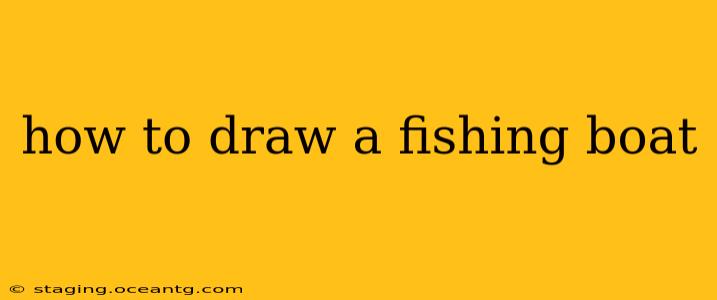How to Draw a Fishing Boat: A Step-by-Step Guide for Beginners and Beyond
Drawing a fishing boat might seem daunting, but with a few simple steps and techniques, you can create a realistic and engaging image, whether it's a small rowboat or a large trawler. This guide will walk you through the process, catering to both beginners and those looking to refine their skills.
1. Basic Shapes: Laying the Foundation
Before diving into intricate details, start by sketching the fundamental shapes of your fishing boat. Think of it as building with blocks. You'll primarily use rectangles, trapezoids, and triangles.
- The Hull: Begin with a long rectangle for the main body of the boat. This represents the hull. Adjust the length and width to determine the boat's size and style.
- The Bow (Front): Add a triangle or a gently curved shape to the front of the rectangle to form the bow. The shape of the bow can vary greatly depending on the type of boat.
- The Stern (Rear): Similarly, shape the back of the boat (the stern). This might be a straight line, a slightly curved line, or a more complex shape depending on the design.
- The Cabin (Optional): If your fishing boat has a cabin, sketch a smaller rectangle or square on top of the hull, towards the stern.
2. Refining the Shape: Adding Curves and Details
Now, refine the basic shapes, adding curves and details to create a more realistic form.
- Smooth the Lines: Use smooth, flowing lines to connect the various shapes, creating a more natural look. Avoid harsh, angular lines unless you're aiming for a very stylized depiction.
- The Waterline: Indicate the waterline with a slightly curved horizontal line around the hull. This shows where the boat meets the water.
- The Deck: Lightly sketch the deck (the top surface) of the boat. This will define the area where the fishermen would stand or work.
- The Gunwales: Add a slightly raised line along the edges of the deck; these are the gunwales.
3. Adding the Features: Bringing it to Life
Once the basic shape is complete, add the essential features of a fishing boat.
- The Mast: If your boat has a mast (for sails or navigational equipment), draw a vertical line rising from the deck.
- Fishing Gear: Sketch in fishing nets, fishing rods, or other relevant gear. Consider the type of fishing the boat is designed for—a small rowboat would have different gear than a large trawler.
- Outboard Motor (or Propeller): If the boat has an outboard motor, draw it on the stern.
- Cabin Details (Optional): Add windows or doors to the cabin, if applicable.
- Ropes and Lines: Add details like ropes and lines for tying up the boat or securing fishing gear.
4. Shading and Texture: Adding Depth and Realism
The final step is to add shading and texture to give your drawing a sense of depth and realism.
- Light Source: Decide on a light source (e.g., the sun) to guide your shading. Areas facing the light will be lighter, while those away from the light will be darker.
- Hatching and Cross-Hatching: Use hatching (parallel lines) and cross-hatching (overlapping lines) to create shading and texture.
- Highlights: Add small white areas to represent highlights where the light reflects off the boat's surface.
What kind of fishing boat are you drawing? Different boats have different features.
- How to draw a small fishing boat (rowboat): Focus on the simple hull, a flat bottom, and oars.
- How to draw a trawler: Concentrate on the large hull, the high deck, and potentially a net or other fishing equipment.
- How to draw a sailboat fishing boat: Incorporate a sail, mast, and rigging.
By following these steps and experimenting with different styles and techniques, you'll be well on your way to creating impressive drawings of fishing boats. Remember, practice is key! Start with simple sketches and gradually work your way towards more complex designs.
How to draw a fishing boat for kids?
Simplify the shapes even further. Use basic geometric shapes and focus on the key features, like the hull and a simple cabin. Bright colors and simple details make it fun for kids!
Remember to have fun and let your creativity flow! Don't be afraid to experiment and find your own style.
